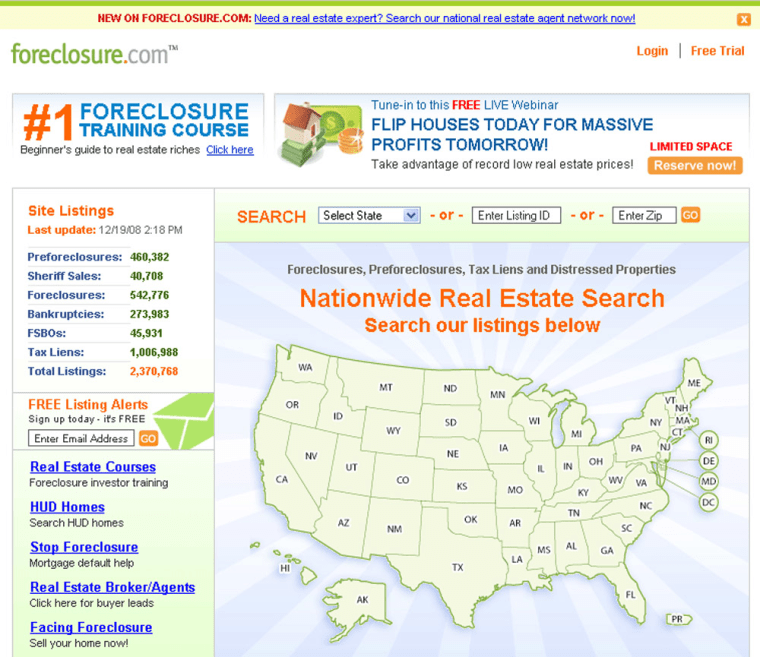Foreclosure search Web sites have grown increasingly popular as more would-be homebuyers have begun focusing on finding distressed properties.
But discerning which site works best isn't easy: Most boast they've got the most listings and charge users a fee for all but the most basic property details.
Their results can vary widely, too.
I searched a single ZIP code in the Los Angeles area on several of the better-known sites and found as few as 53 listings to more than 1,000.
The sites find foreclosures through a variety of ways, with some collecting information on foreclosure-related filings from various county recorder's offices, title companies, lenders and other sources.
Several types of documents are generated when a home enters the foreclosure process, beginning with a notice of default, a phase some refer to as pre-foreclosure. This stage reflects that a homeowner has fallen behind on their mortgage payments, but could conceivably catch up and not necessarily lose their home.
Other documents the sites look for are notices of trustee sales and notices of repossession, when a property goes back to the bank, also known as a "real estate owned property" or REO.
If popularity is any indicator, Foreclosure.com and RealtyTrac.com are among the top foreclosure sites at the moment.
In the four weeks ended Dec. 13, Foreclosure.com received 26.5 percent of all online traffic visits after users searched Web sites for the word "foreclosure," according to the research firm Hitwise.
RealtyTrac was ranked second, with 17.1 percent of visits, in the same period, Hitwise said.
ForeclosureStore and ForeclosureToGo each have been on the rise of late, entering the top 100 real estate Web sites in November.
The more popular real estate listings Web sites, such as Zillow.com and Trulia.com, typically display foreclosure filings culled from other sites.
Zillow lists foreclosure listings from Foreclosure.com, while Trulia displays listings from RealtyTrac Inc.
So it makes sense to go to the source.
Many of the sites I tried had common search features, allowing users to look up homes in some stage of foreclosure by ZIP code, city and state. Some break out listings according to where they are in the foreclosure process and also include homes involved in a bankruptcy, for sale by owner and those with tax liens.
Most sites allow users to see a partial address, and some details on the property, such as how many bedrooms and bathrooms and square feet.
But for a full look at foreclosure data on listings, users have to pay monthly fees ranging from $39.80 to $79.95, going by the sites I examined. Many offer a free trial period of a week to try the full services, although a credit card is typically required to do so.
RealtyTrac's free access gets you listings with incomplete addresses, although I found a couple of exceptions.
It also breaks out results by foreclosure stage and in addition to displaying photos when available and other basic details, it provides an aerial shot of the properties.
To access enhanced features, such as a map of comparably priced properties, a listing's loan history, liens, and when and how the property has changed hands, for example, one must sign up for the a subscription, which runs $49.95 a month.
Rick Sharga, RealtyTrac's vice president for marketing, says the site has 1.9 million foreclosure and bank-owned properties, with about 1 million of those listings homes that have yet to be repossessed.
By comparison, Foreclosure.com boasts more than 1.8 million listings, which users can sort through by stage of foreclosure.
The site says it gets its listings from foreclosing lenders, government agencies and corporate sellers. A subscription costs $39.80 a month.
A site eerily similar in look, feel and pricing to Foreclosure.com is ForeclosuresToGo.com.
In my test drive, the site returned listings missing with photos and other basic information, such as the number of rooms. The site offers a status for the properties, but only one was labeled as "new."
A relatively recent entrant to the foreclosure listing search business, ForeclosurePoint.com, has sought to stand out by letting users see listings' full addresses for free.
That can enable a buyer to approach a homeowner who might be in default and willing to pursue a short sale, says ForeclosurePoint spokesman Cary Brazeman.
"If you're a homebuyer interested in a single home ... why pay anybody?" he says.
The site, which launched in June, says it tracks filings on about 2 million properties in some stage of foreclosure, although its reach only extends to 34 states. Its premium membership is among the highest around at $79.95 a month, and includes the ability to track multiple properties at a time and receive timely alerts on when they are up for auction, opening bids and more.
Those extras, Brazeman notes, are aimed more for professional real estate investors.
For regular homebuyers, experts suggest they avoid paying fees at all and use the Web sites merely as a way to benchmark what foreclosure prices are like in a given area.
"They're not always up to date, they're don't always have the most current information," says Delores Conway, director of the Casden Real Estate Economics Forecast at the University of Southern California.
Instead, she suggests homebuyers approach real estate brokerages and ask for the agent who has done the most foreclosure transactions, because they'll generally have the most up to date information on a listing.
